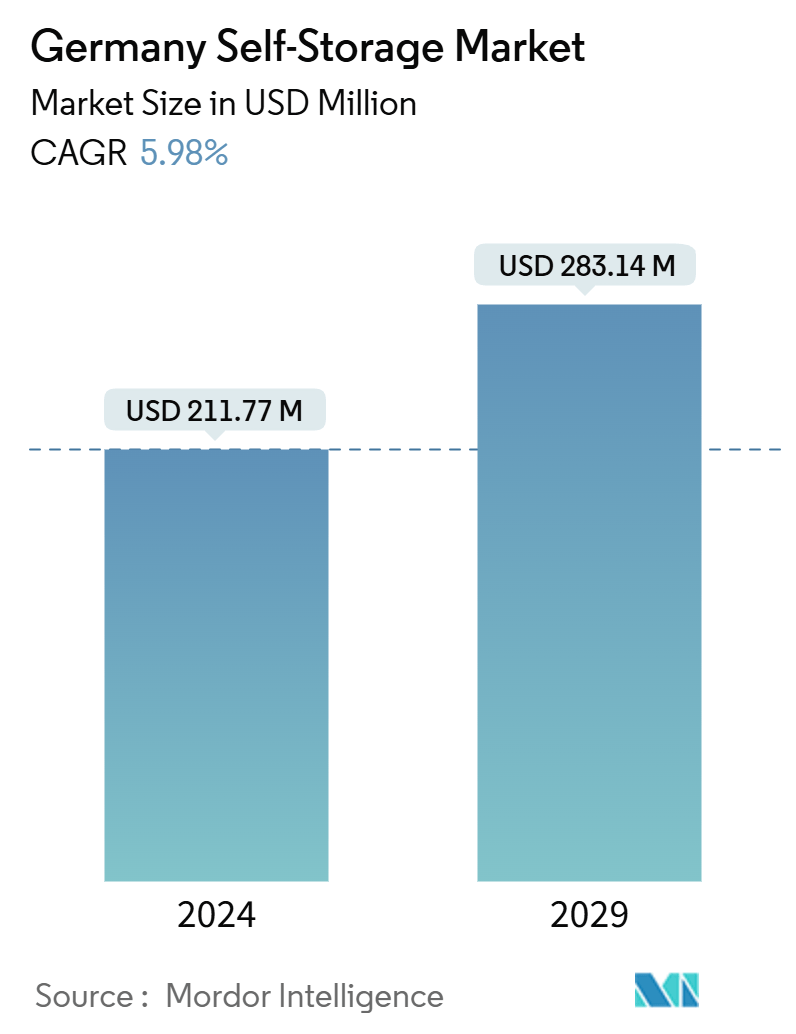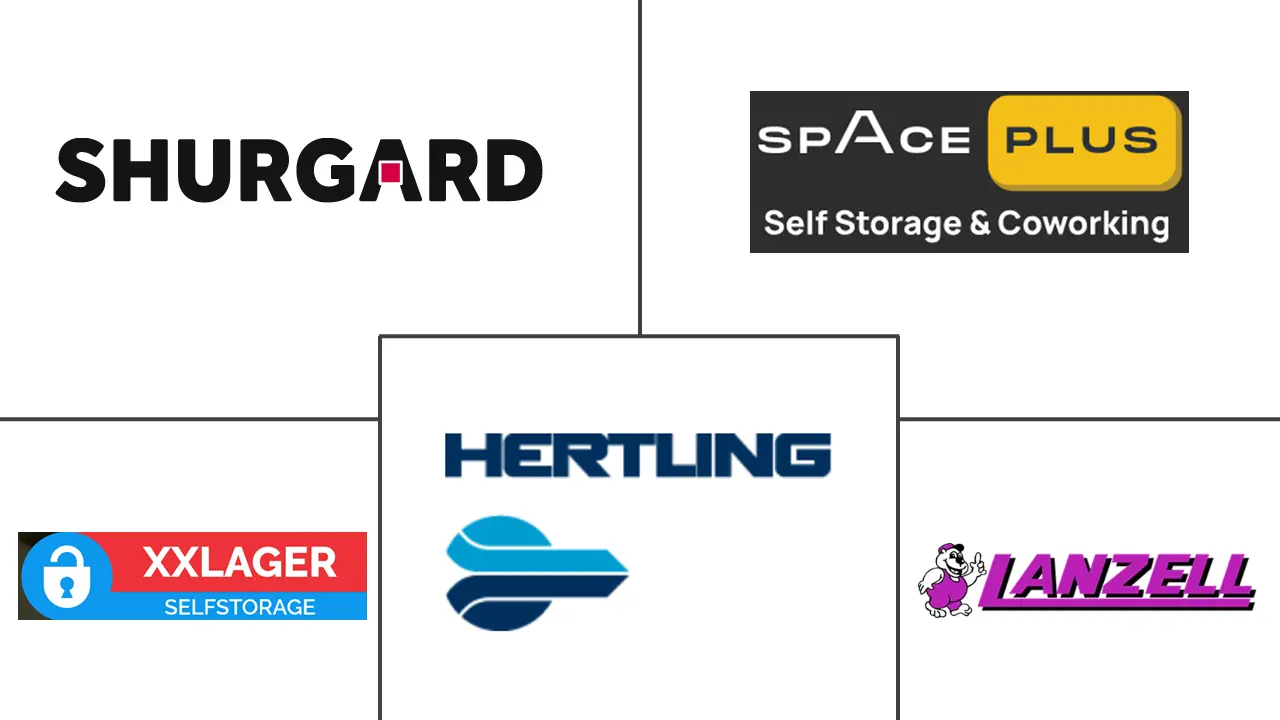Market Size of Germany Self-Storage Industry

| Study Period | 2019 - 2029 |
| Base Year For Estimation | 2023 |
| Market Size (2024) | USD 211.77 Million |
| Market Size (2029) | USD 283.14 Million |
| CAGR (2024 - 2029) | 5.98 % |
| Market Concentration | Low |
Major Players
*Disclaimer: Major Players sorted in no particular order |
Germany Self-Storage Market Analysis
The Germany Self-Storage Market size is estimated at USD 211.77 million in 2024, and is expected to reach USD 283.14 million by 2029, at a CAGR of 5.98% during the forecast period (2024-2029).
The self-storage industry is a subsector of the commercial real estate market. The growth in this industry is expected to be positive during the forecast period, owing to increased urbanization and an improved economic outlook across the regions, which have led to new business growth.
- Germany has a comparatively low penetration of the self-storage market compared to other European countries, but demand is increasing from personal and commercial customers, which is contributing to the growth rate of the market. As a result, new vendors are entering the market to gain maximum market share in a country with low market penetration.
- Due to a scarcity of available space, Germany offers a variety of growth opportunities for the self-storage industry. This is particularly the case in large cities with dense populations.
- The major factors fueling the expansion of the German self-storage sector are rising urbanization and a decline in available living space. The need for space consequently rises as urbanization grows, pushing up the price of real estate per square meter. Hence, these elements are fueling market expansion. However, government regulations are expected to challenge the market's growth.
- Although self-storage was originally intended for personal storage, businesses have slowly realized the importance of self-storage facilities. For small businesses, renting a self-storage unit would be a cost-effective, short-term, or long-term solution for addressing space management issues.
- The COVID-19 pandemic positively impacted the growth of self-storage facilities in the country. Occupancy levels across self-storage facilities have grown significantly since the start of the pandemic.
Germany Self-Storage Industry Segmentation
Self-storage facilities give people access to space to rent and store household or business possessions. Rental agreements for storage space, often known as storage units, are month-to-month agreements. Self-storage allows the user much greater control than full-service storage options, which restrict the customers' access to their possessions and depend on the storage provider to maintain and manage them.
The German self-storage market is defined based on the revenues generated from the services used by various user types. The analysis is based on the market insights captured through secondary research and the primaries. The market also covers the number of self-storage facilities, total lettable area, occupancy rate (%), and average rent per square meter, along with major factors impacting the growth of the market in terms of drivers and restraints. The study tracks the key market parameters, underlying growth influencers, and major vendors operating in the industry, which supports the market estimations and growth rates over the forecast period. The study also tracks the revenue accrued from the self-storage services that are being used across Germany. In addition, the study provides Germany's self-storage market trends and future outlook. The study further analyzes the overall impact of COVID-19 on the ecosystem.
The German self-storage market is segmented by user type (personal, business). The market sizes and forecasts are provided in terms of value (USD) for all the above segments.
| By User Type | |
| Personal | |
| Business |
Germany Self-Storage Market Size Summary
The German self-storage market is poised for steady growth, driven by increasing urbanization and a tightening real estate market. As more people move to urban areas, the demand for additional storage space is rising, creating opportunities for self-storage facilities to expand. Despite having a lower penetration rate compared to other European countries, the market is witnessing a surge in demand from both personal and commercial customers. This demand is attracting new entrants to the market, eager to capitalize on the growth potential in a region where space is becoming increasingly scarce. The market's expansion is further supported by the trend of downsizing living spaces, which necessitates the need for convenient and cost-effective storage solutions.
Businesses are also recognizing the value of self-storage facilities as a practical solution for managing space constraints. These facilities offer a secure and flexible alternative to traditional storage options, allowing companies to store inventory, documents, and equipment without the need for permanent warehouse space. The market is characterized by a fragmented landscape with key players like XX LAGER Self Storage and Hertling GmbH & Co. KG actively expanding their offerings through strategic partnerships and new developments. Recent initiatives, such as Shurgard's expansion plans in major German cities, highlight the growing interest in self-storage as a viable business opportunity. As the market continues to evolve, it is expected to attract more commercial renters, further driving its growth trajectory.
Germany Self-Storage Market Size - Table of Contents
-
1. MARKET INSIGHTS
-
1.1 Market Overview
-
1.2 Industry Attractiveness - Porter's Five Forces Analysis
-
1.2.1 Bargaining Power of Suppliers
-
1.2.2 Bargaining Power of Buyers
-
1.2.3 Threat of New Entrants
-
1.2.4 Threat of Substitutes
-
1.2.5 Intensity of Competitive Rivalry
-
-
1.3 Industry Value Chain Analysis
-
1.4 Assessment of the Impact of COVID-19 on the Market
-
-
2. MARKET SEGMENTATION
-
2.1 By User Type
-
2.1.1 Personal
-
2.1.2 Business
-
-
Germany Self-Storage Market Size FAQs
How big is the Germany Self-Storage Market?
The Germany Self-Storage Market size is expected to reach USD 211.77 million in 2024 and grow at a CAGR of 5.98% to reach USD 283.14 million by 2029.
What is the current Germany Self-Storage Market size?
In 2024, the Germany Self-Storage Market size is expected to reach USD 211.77 million.

